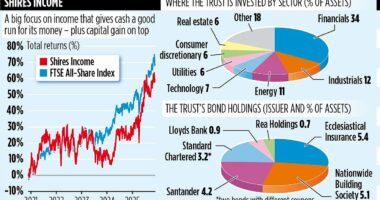Share this @internewscast.com
Lending money to the Government by buying its ‘gilts’ direct is seen as a low-risk and lucrative earner by a growing number of investors.
You receive a regular income, known as the coupon, and if you hang on until the maturity date you get all your money back – except in the unlikely event the UK defaults on its debt.
DIY investing brokers have made it easy to buy single gilts and stash them in your Isa, while financial advisers increasingly tend to recommend them to higher earners who have already maxed out their Isas for the tax perks.
Although you can certainly opt to buy and hold, if you are able to sell at a profit earlier you can make a saving on capital gains tax, which isn’t levied on gilts.
Many individual investors find it easier to buy a bond fund and let a manager do the hard work – see more on the this below.
But if you are keen to buy gilts direct and willing to do your homework, here’s what you need to know.
What are gilts?
Governments around the world issue bonds in order to borrow money to help pay their bills – the UK’s bonds are called ‘gilts’.
Investors, including banks, insurers and pension funds, as well as individuals, buy them in order to earn a return.
Governments issue bonds with a range of different maturities – three months, a year, 10 years, 30 years and so on. This is the length of time governments are giving themselves to pay back investors.
Short-dated bonds are those that mature fast, and in normal times are deemed less risky as a result.
Long-dated bonds are those where investors have to wait a while to see their money again, and are regarded as riskier because there is more time for things to go wrong.
This means rates of return are low on gilts that mature quickly, but can vie with current savings rates or beat them on the longer-dated ones.
You can get your money back at the end, or sell earlier on the secondary market and, depending on values of gilts then, may get more than you originally paid.
Some investors buy gilts direct that will mature serially over time – something known as building a ‘gilt ladder’.
The value of a bond is both the capital gain that you could make should you sell it and the coupon that you receive.
Dan Coatsworth, investment analyst at DIY platform AJ Bell, says: ‘Gilts may appeal to income-seekers.
‘However, there are still some dangers of which patient portfolio builders should be aware, so they can factor them into their study of whether the coupon on offer is sufficient to justify these risks and that the instrument’s return profile fits with their overall investment strategy, target return, time horizon and appetite for risk.’
He says investors should bear in mind the risk the issuer defaults, liquidity risk – meaning is a gilt’s issue size large enough to make it easy to buy and sell in the secondary market – interest rate changes that can hit bond prices, and inflation risk which can erode your real return.
Why is buying gilts direct attractive for higher earners?
Gilts can be very tax efficient, especially for those paying higher tax rates looking to invest outside Isas and pensions.
While the coupon is subject to tax, just like cash savings interest if you exceed your personal savings allowance, price gains are exempt from capital gains tax.
This works with gilts with low coupons, where you make a gain on any uplift from your original purchase price.
But Jason Hollands, managing director of wealth manager Evelyn Partners, cautions that individual investors must be ready to do some maths regarding ‘yield to maturity’ and post-tax yield on gilts to make this work.
‘It isn’t quite as straightforward as picking the ones with the highest headline yields’ he says.
‘What really matters is the post tax yield to maturity and that involves calculating the different impact of tax on interest coupons and tax-exempt price gains between now and when the gilt matures.
‘If you look at platforms offering execution-only dealing in gilts, the information provided is typically limited to coupon, maturity date and price – so you’d have to work out the yield to maturity yourself, and then the post-tax yield.
‘An investor who is unfamiliar with direct investing in bonds might just hone in on the coupon, so it is easy to make a mistake.
‘If you’re looking for a more tax efficient home and better returns for a sizeable cash pile, it can make sense to speak to a wealth manager which can build a gilt ladder or a cautious cash-equivalent and shorter-dated portfolio.’
How do you invest in gilts direct
Many of the top DIY investing platforms including Hargreaves Lansdown, Interactive Investor and AJ Bell offer gilts. You can keep a check on their sites for a list of what’s currently available, or you may be able to sign up for alerts on upcoming issues.
Gilts are often sold at short notice and for limited periods, and if you miss out you would have to buy on the open (also known as secondary) market when the price might already have risen.
You can also buy direct from the UK Debt Management Office, which offers a service run by Computershare. You have to be a member of its ‘Approved Group’, which means you live in the UK and pass its identity and money laundering rules.
If you are an existing customer at a broker it’s likely your buyer status is already established, so you can purchase gilts online like any other investment.
Regarding costs, DMO charges start at 0.7 per cent or a minimum of £12.50 on gilt purchases worth up to £5,000, or check with your own platform.

The Government issues new debt, called gilts, to help fund its business, from borrowing to fulfilling spending commitments, and rolling over older debt
Should you opt for a bond fund instead?
You can get exposure to gilts, and other overseas bonds and corporate bonds, by buying bond funds.
Here, a manager does the work of deciding which bonds to buy or sell, and spreads the risk as their value rises or falls over time.
A professional will be better placed to forecast bond market moves, watch for changes in inflation, and monitor interest rates which heavily influence bonds as investors seek to beat them.
Buying a bond fund means stumping up management fees though, and you don’t get the option of holding individual bonds to maturity and getting your capital back.
DIY INVESTING PLATFORMS
AJ Bell

AJ Bell
Easy investing and ready-made portfolios
Hargreaves Lansdown

Hargreaves Lansdown
Free fund dealing and investment ideas
interactive investor

interactive investor
Flat-fee investing from £4.99 per month
InvestEngine

InvestEngine
Account and trading fee-free ETF investing
Trading 212
Trading 212
Free share dealing and no account fee
Affiliate links: If you take out a product This is Money may earn a commission. These deals are chosen by our editorial team, as we think they are worth highlighting. This does not affect our editorial independence.
Compare the best investing account for you









